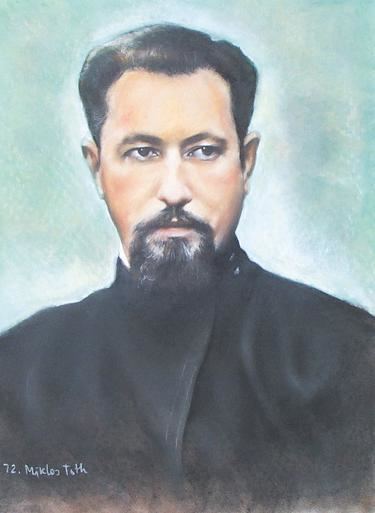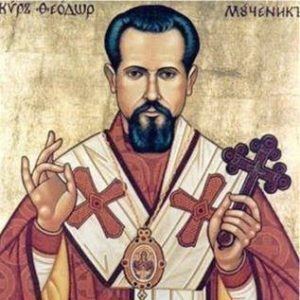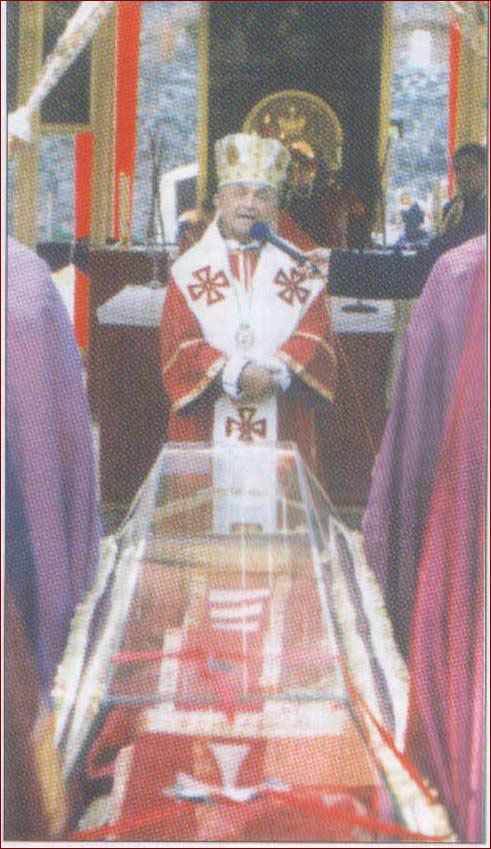Term ended 31 October 1947 Ordination December 25, 1936 Predecessor Oleksandr Stoika Beatified June 27, 2001 | Name Theodore Romzha Appointed September 8, 1944 Consecration September 24, 1944 | |
 | ||
Church Ruthenian Catholic Church Feast day 31 October (martyrdom); 28 June (translation of relics) Venerated in Greek Catholic ChurchesRoman Catholic Church Diocese Ruthenian Catholic Eparchy of Mukacheve | ||
Life and legacy of blessed theodore romzha
Blessed Theodore Romzha (Ukrainian: Теодор Юрій Ромжа, Hungarian: Tódor György Romzsa, 14 April 1911 – 31 October 1947) was bishop of the Ruthenian Catholic Eparchy of Mukacheve from 1944 to 1947. Assassinated by NKVD, he was beatified as a martyr by Pope John Paul II on 27 June 2001.
Contents
- Life and legacy of blessed theodore romzha
- Blessed theodore romzha seminary choir concert
- Early life
- Episcopate
- Feast day and Relics
- References

Blessed theodore romzha seminary choir concert
Early life

Theodore Romzha was born in the Subcarpathia region, Hungary, Austria-Hungary (in the Rusyn village Velykyi Bychkiv, now Ukraine) on 14 April 1911.

His father, Pavel Romzha, worked as an official of the railroad. His mother, the former Maria Semack, was a full-time homemaker. Like many ambitious families in the region, the Romzhas spoke the Hungarian language in the home. In the presence of others, however, they switched to their native Rusyn language. After his graduation from the Gymnasium in Khust, Theodore left to study for the priesthood in Rome. He began as a seminarian at the Collegium Germanicum, but later switched to the Russicum.

Theodore was ordained a priest there by Bishop Aleksander Evreinov on Christmas Day, 1936 in the Basilica of St Mary Major. After completing his compulsory military service he served briefly as a pastor in several Transcarpathian parishes (part of Czechoslovakia since 1918) before being assigned as professor of philosophy at the Eparchial Seminary in Uzhhorod in 1939, now given back to Hungary.
Episcopate

These were difficult years for the Church in Subcarpathia as it experienced the invasions, later in 1938 by Hungary, one of Axis powers during the Second World War, then direct rule from Nazi Germany and lastly the Soviet Red Army.

On 24 September 1944, at the young age of 33, he was consecrated bishop and appointed apostolic administrator of the Eparchy of Mukacheve in the cathedral of Uzhorod by Bishop Miklós Dudás, O.S.B.M.. He immediately had to face the Soviet Red Army, which occupied the churches, assigned them to the Russian Orthodox Church and arrested their priests. Bishop Romzha refused to break with the Pope in front of General Petrov.
He organized a celebration of the Feast of the Assumption with the participation of more than 80,000 pilgrims but this was not tolerated by the Communist officials who now began plotting to dispose of the young bishop. On 27 October 1947, on the way home from a parish visitation, Bishop Romzha's horse-drawn carriage was purposely rammed by a Soviet military truck and pushed off the side of the road. The soldiers, who were dressed as civilians, jumped from the truck and beat the bishop and his companions.
Soon after the brutal assault began, a civilian truck came upon the scene and the assailants fled. Romzha and his companions were taken to Uzhhorod, where they were hospitalized. Romzha was making good progress when, late on the night of 31 October, the nuns who were nursing him were suddenly dismissed and a new nurse was assigned to him by the regime. A little after midnight Moscow Time, Romzha was found dead. The nurse had poisoned Romzha with an injection of curare provided by the head of NKVD Laboratory 12, Dr Grigory Mairanovsky. According to research in Soviet archives by Yevgenia Albats, the Bishop's murder was personally ordered by Nikita Khrushchev.
On 4 November 1947, a large crowd attended Romzha's funeral, despite Soviet efforts to shut down and block public transportation. He was buried in the crypt of the Holy Cross Cathedral in Uzhhorod. The Ruthenian Catholic Church was relentlessly persecuted and in 1949, it was officially suppressed. All of its properties were allocated to the Russian Orthodox Church.
Feast day and Relics
Romzha was beatified as a Martyr for the Faith by Pope John Paul II in Lviv on 27 June 2001, with 1 November assigned initially as his feast day. At the request of the Eparchy of Mukacheve, the Congregation for Oriental Churches transferred the feast day to 31 October, effective 2009. Romzha died shortly after midnight 1 November, according to Moscow Time, the Soviet-imposed time zone throughout Ukraine from 1930-1990; however, according to local time, Romzha died before midnight on 31 October.
In 1998, the relics of Blessed Theodore were found in a tomb in the crypt of Holy Cross Cathedral in Uzhhorod, and then transported to Budapest, Hungary for medical examination. On 27-28 June 2003 his relics were translated and carried in solemn procession back to Uzhhorod, where they are enshrined in a side chapel at Holy Cross Cathedral. In commemoration of the event, a second feast day, the Translation of the Holy Relics of Blessed Theodore Romzha, is celebrated on 28 June.
